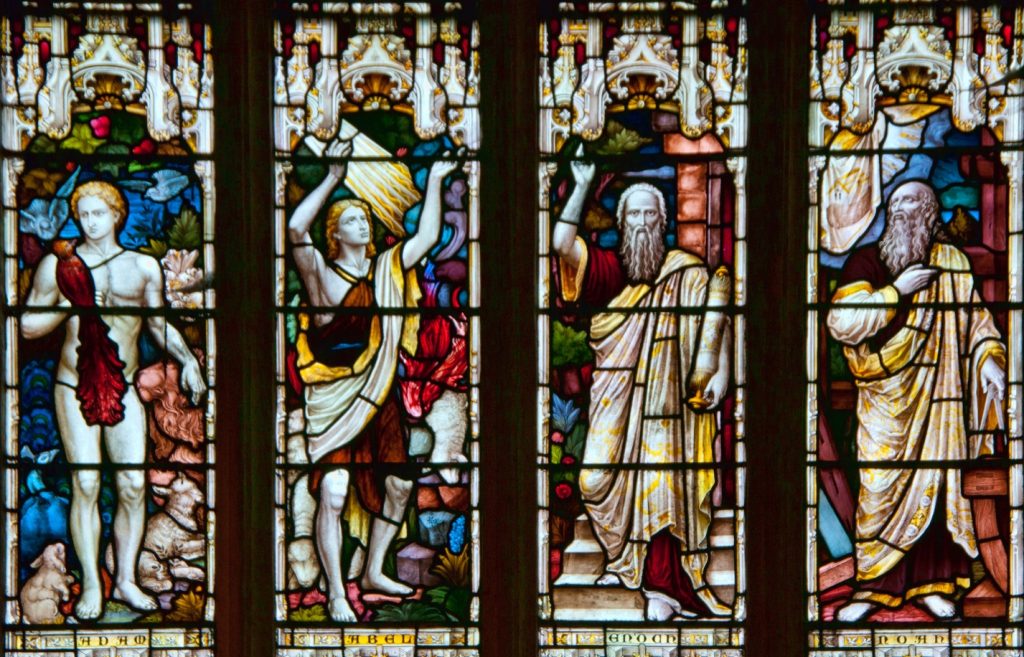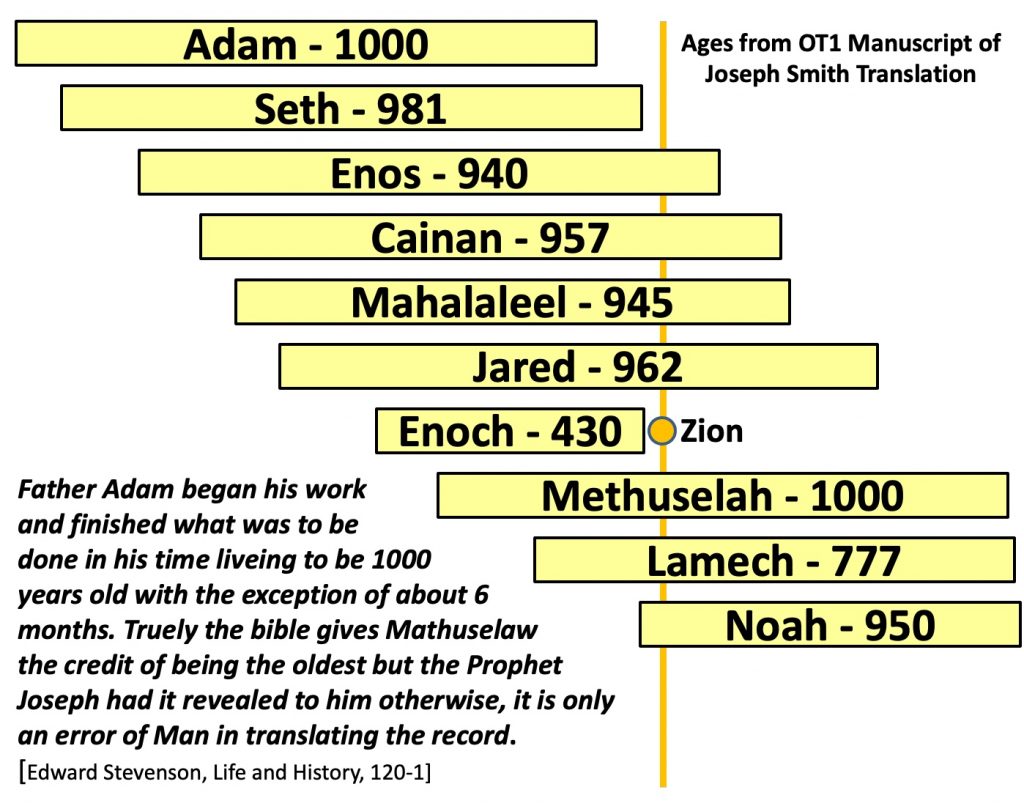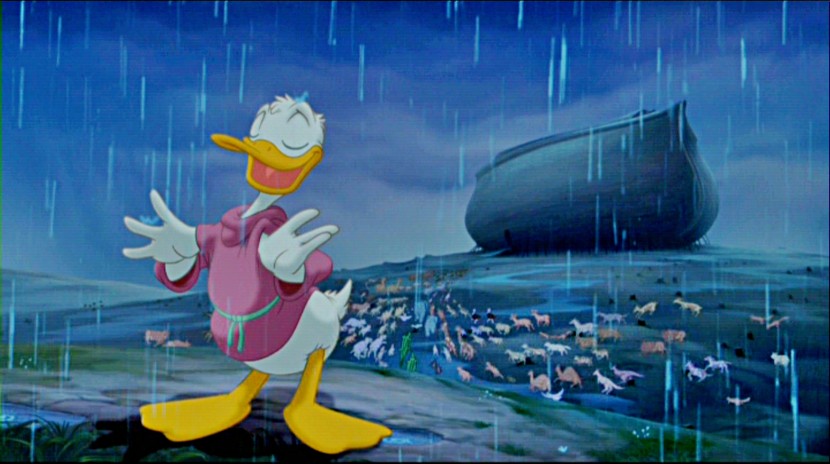This series is cross-posted with the permission of Book of Mormon Central
from their website at Pearl of Great Price Central
Audio Player

Figure 1. J. James Tissot, 1836-1902: The Birth of Noah (Genesis 5:29), ca. 1896-1902.
The painting by Tissot shown above highlights the great anticipation for Noah’s birth that appears in many ancient traditions. For example, in the pseudepigraphal book of 1 Enoch, Noah’s appearance and actions as a newborn are described in ways that resemble a “‘full-grown’ heavenly being”:[1] “And when the child was born, his body was whiter than snow and redder than a rose, his hair was all white and like white wool and curly. Glorious [was his face]. When he opened his eyes, the house shone like the sun. And he stood up from the hands of the midwife, and he opened his mouth and praised the Lord of eternity.”[2] Apparently, these wonders were meant to be seen as signs and portents of Noah’s future achievements:[3] “His posture of praise anticipates his priestly duties after the Flood.[4] His glorious birth prefigures … the way his life will bring glory to creation just as the high priest glorifies the sanctuary.” Continuing with the 1 Enoch account, we read how Lamech was astonished at Noah’s appearance, worrying that the Noah was not his child but rather was fathered by “the angels.”[5] He went to see his father Methuselah, who in turn traveled to inquire of Enoch “at the ends of the earth.”[6] Enoch set Methuselah’s mind at rest, telling him that Noah was indeed Lamech’s child and that his mission would be to “cleanse the earth from the corruption that is on it.”[7] Moreover, he prophesied that Noah “and his three children [would] be saved with him, when all men on earth die.”[8]

Figure 2. Window of the Patriarchs, Holy Trinity Church, Stratford Upon Avon, England. Notice the progression in clothing from left to right, perhaps indicating the artist’s ideas about the presumed maturity of civilization in different eras. Later prophets also seem to get more hair. Enoch and Noah sport similar beards and clothing, but Noah’s beard and fabric seem a little thicker.[9]
Noah: A Prophet Like Adam
Noah is given a place of notable prominence in modern revelation, standing second only to Adam in having dominion over every living creature. The Prophet Joseph Smith taught:[10]
The Priesthood was first given to Adam; he obtained the First Presidency, and held the keys of it from generation to generation. He obtained it in the Creation, before the world was formed, as in Genesis 1:26–28. He had dominion given him over every living creature. He is Michael the Archangel, spoken of in the Scriptures. Then to Noah, who is Gabriel: called of God to this office, and was the father of all living in this day, and to him was given the dominion. These men held keys first on earth, and then in heaven.
Gabriel (Noah) and Michael (Adam) are the only angels mentioned by name in the Bible (Daniel 10:13, 21; 12:1; Jude 1:9; Revelation 12:7). Gabriel interprets Daniel’s dreams (Daniel 8:16, 9:21) and announces the births of John the Baptist and Jesus (Luke 1:19, 26). In Muslim teachings, Gabriel (Jibra’il) not only reveals God’s word to Muhammad,[11] but also appears along with the Devil (Iblis) “in almost all the episodes”[12] of the stories of the prophets.[13] There is also a worldwide literature concerning variously named Flood heroes (e.g., Nu’u,[14] Nuh,[15] Nu Gua,[16] Atrahasis,[17] Utnapishtim,[18] Ziusudra,[19] Deucalion,[20] Yima,[21] and Manu.[22]).

Figure 3. Stephen T. Whitlock: Relative Ages of the Patriarchs.
Modern revelation amplifies what we know about Noah from the Bible. His birth was a fulfillment of a covenant God made with Enoch (7:52). He was ordained to the priesthood at age ten (Doctrine and Covenants 107:42–51). He taught the first principles and ordinances of the Gospel and announced the coming of Jesus Christ in the meridian of time (8:16, 19, 23–24). He conferred the priesthood upon his posterity (Doctrine and Covenants 84:14–15). As part of the restoration of the Gospel, he visited the Prophet Joseph Smith (Doctrine and Covenants 128:21). Finally, modern revelation teaches that after the Second Coming, Noah will return to the earth to attend the marriage supper of the Lamb (Doctrine and Covenants 27:5–7).
In the three essays relating to Noah, we will put a major focus on temple symbolism. That the story of Noah repeats, with some variation, the themes of the Creation, the Garden of Eden, and the Fall of Adam and Eve has long been recognized by Bible scholars. What deserves greater appreciation, however, is the nature and depth of the relationship between these accounts and the liturgy and layout of temples, not only in Israel but also throughout the ancient Near East.[23]

Figure 4. Donald Duck Gathers the Animals to the Ark, 1999.
Taking the Stories of Primeval History Seriously
Given their status as targets of humor and caricature, the well-worn stories of Adam, Eve, and Noah are sometimes difficult to take seriously. However, a thoughtful examination of the scriptural record of these characters will reveal not simply tales of “piety or … inspiring adventures”[24] but rather carefully crafted narratives from a highly sophisticated culture that preserve “deep memories”[25] of revealed understanding. We do an injustice both to these marvelous records and to ourselves when we fail to pursue an appreciation of scripture beyond the initial level of cartoon cut-outs inculcated upon the minds of young children.[26] Hugh Nibley characterized the problem this way:[27]
The stories of the Garden of Eden and the Flood have always furnished unbelievers with their best ammunition against believers, because they are the easiest to visualize, popularize, and satirize of any Bible accounts. Everyone has seen a garden and been caught in a pouring rain. It requires no effort of imagination for a six-year-old to convert concise and straightforward Sunday-school recitals into the vivid images that will stay with him for the rest of his life. These stories retain the form of the nursery tales they assume in the imaginations of small children, to be defended by grown-ups who refuse to distinguish between childlike faith and thinking as a child when it is time to “put away childish things.”[28] It is equally easy and deceptive to fall into adolescent disillusionment and with one’s emancipated teachers to smile tolerantly at the simple gullibility of bygone days, while passing stern moral judgment on the savage old God who damns Adam for eating the fruit He put in his way and, overreacting with impetuous violence, wipes out Noah’s neighbors simply for making fun of his boat-building on a fine summer’s day.[29]

Figure 5. In Search of Noah’s Ark, 1976.
Adding to the circus-like atmosphere surrounding modern discussions of Noah’s flood are the sometimes acrimonious contentions among fundamentalist proponents concerning the different theories about where the Ark came to rest.[30] Nicolas Wyatt reports:[31]
I once watched a television programme of excruciating banality, in which a camera team accompanied an American “archaeologist” (for so he called himself) on his quest for the remains of Noah’s ark on Mount Ararat. The highlight for me occurred when a rival crew was encountered at several thousand feet … above sea level heading in the opposite direction, on the same quest!

Figure 6. Enki Inserts a Computer Disk.
Unfortunately, Mesopotamian studies are no more exempt from such quackery than is Old Testament scholarship. The following description is given for figure 6 by Sasha Lessin, PhD:[32]
Galzu tells Enki (depicted with his snake icon) to warn Ziasudra [sic] (touching the “wall” — probably a computer bank, depicted with Xs across the screens and slots for programs) of the Flood. Galzu guides Enki’s arm to convey tablet (possibly a computer or holo disk. The disk leaves Enki’s hand en route to Ziasudra’s computer).[33]

Figures 7a, b. Russell Crowe as Noah; A “Watcher” on the Attack.
Sensing that there is money to be made in Noah’s story, Hollywood has made sure that it is not left out of the fun. At left is Russell Crowe as Noah in a film adaptation that Paramount officially has called a “close adaptation of the Biblical story.”[34] Careful Bible readers understandably cringe at director Darren Aronofsky’s description of Noah as “‘a dark, complicated character’ who experiences ‘real survivor’s guilt’ after surviving the Flood.”[35] Accordingly, he portrays the prophet with perfect scriptural fidelity as a “Mad Max-style warrior surviving in a pseudo post-apocalyptic world.”[36] Students of the Bible may not recognize the portrait at right above as depicting one of the “Watchers,” drawn in exact correspondence to the graphic novel that inspired the movie as “eleven-foot-tall fallen angels with six arms and no wings.”[37]
The profound accounts of primeval history deserve better treatment. To understand them for what they are, we need to bring our best to the task: the powerful tools of modern scholarship, the additional light shed by modern revelation, and, of no less importance, the consecrated dedication of inquiring minds and honest hearts diligently seeking divine inspiration. The simple fantasies of what Joseph Smith aptly described as a “fanciful and flowery and heated imagination”[38] will not suffice.
Noah and His Sons
Moses 6:5-23 describes the ideal family order established by Adam and Eve. This same order is implied in Moses 8:13, where Noah and his righteous sons are mentioned. The patriarchal order of the priesthood “which was in the beginning” and “shall be in the end of the world also”[39] is depicted as presiding over a worthy succession of generations in the likeness and image of Adam,[40] just as Adam and Eve were made in the image and likeness of God.[41]
Indeed, transcending his status as a king and priest, Noah is sometimes portrayed in the Bible as a type of God Himself.[42] Consider for example, the microcosmic Ark that Noah forms and fills with living creatures and food in imitation of the Creator God[43] and his role as captain of the Ark as it moved “upon the face of the waters”[44] — assuming the role of God in the original creation of the earth.[45] Recall also Noah’s planting of an Eden-like garden after the emergence of dry land,[46] his later locus “in the midst of”[47] the most sacred place in that Garden and his pronouncement of a curse upon Canaan, the “serpent” who was responsible for the transgression of its sacred boundary.[48]
With reference to Noah’s quasi-divine status, note that in 1 Enoch, his appearance at birth was described as so glorious that “when he opened his eyes the whole house shone like the sun,”[49] and it is not insignificant that, in the Book of Moses, Noah’s three children are explicitly called the “sons of God.”[50] Noah’s high standing in the eyes of God can be compared with that of Enoch, who was the only other mortal in scripture said to have “walked with God.”[51] Litwa understands the phrase “walked with God” to signify “travel[ing] back and forth with the gods,”[52] and in the case of Enoch he associates the idea with deification.[53] Likewise, in the account of Berossus, the flood hero does not die, but like Enoch and Utnapushtim is taken suddenly from earth and “translated to live with the gods.”[54] Indeed, Enoch and Noah, whose names are mentioned together three times in the story of the Flood,[55] are the only two included in the genealogical list of the patriarchs whose deaths are not mentioned.[56] Both “found life amid the curse of death,”[57] both were rescued from death by the hand of God,[58] and each in his turn a rescuer to others.[59] Depictions of Noah in the catacombs show him rising out of the Ark in a pose of resurrection, prefiguring the emergence of the Savior from His tomb.
The “Sons of God” and the “Sons of Men”
In contrast to the antediluvian “preachers of righteousness”[60] in the line of Seth, extracanonical traditions speak of “fornication … spread from the sons of Cain” which “flamed up,” and tell how “in the fashion of beasts they would perform sodomy indiscriminately.”[61]
The term, “sons of God,” as it occurs in the enigmatic episode of mismatched marriages in the Bible[62] and in passages in 1 Enoch[63] has been the source of no end of controversy among scholars.[64] Contradicting traditions that depict these husbands as fallen angels, the Book of Moses and some ancient exegetes portray them as mere mortals.[65] Following what became the standard tradition in the Syriac Church, that saw the “sons of God” as Sethites and the “daughters of men” as Cainites,[66] Ephrem the Syrian interpreted these traditions to mean that: “[T]hose who lived on higher ground,[67] who were called ‘the children of God,’ left their own region and came down to take wives from the daughters of Cain down below.”[68] An Islamic source likewise asserted: “But one errs and misunderstands [if] he says that ‘angels’ descended to ‘mortal women.’ Instead, it is the sons of Seth who descend from the holy mountain to the daughters of Cain the accursed. For it was on account of their saintliness [chastity?] and dwelling place upon the holy mountain that the sons of Seth were called banu ‘elohim; that is, ‘sons of God.’”[69] In the Book of Moses, the episode is related as follows:
13 And Noah and his sons hearkened unto the Lord, and gave heed, and they were called the sons of God.
14 And when these men began to multiply on the face of the earth, and daughters were born unto them, the sons of men saw that those daughters were fair, and they took them wives, even as they chose.
15 And the Lord said unto Noah: The daughters of thy sons have sold themselves; for behold mine anger is kindled against the sons of men, for they will not hearken to my voice.
Noah’s preaching to the “sons of men” was completely unsuccessful. They mocked him, falsely claiming to be “sons of God” themselves:
20 And it came to pass that Noah called upon the children of men that they should repent; but they hearkened not unto his words;
21 And also, after that they had heard him, they came up before him, saying: Behold, we are the sons of God; have we not taken unto ourselves the daughters of men? And are we not eating and drinking, and marrying and giving in marriage? And our wives bear unto us children, and the same are mighty men, which are like unto men of old, men of great renown. And they hearkened not unto the words of Noah.
In sarcastically designating their wives as “daughters of men,” these sons of men deliberately deprecate the status of their wives — daughters of the sons of Noah, who were in reality “sons of God” by virtue of having received the fulness of the priesthood.[70]
Conclusion: The Righteousness of Noah
In Moses 8:27, we are told that “Noah was a just man, and perfect in his generation; and that he walked with God.”
The Hebrew term for “just,” tsaddik, used here for the first time in the Bible, “implies one who is adjudged to be ‘in the right,’ which is its meaning in such texts as Exodus 23:7, Deuteronomy 25:1, and Proverbs 17:15. Accordingly, the term tsaddik describes one whose conduct is found to be beyond reproach by the divine Judge.”[71] Leon Kass notes that the description of Noah’s virtues put us on notice “that it is these qualities, not heroic manliness (prized everywhere else), that are divinely favored.”[72] For almost six hundred years, Noah had remained just in the midst of a corrupt world.
The Hebrew term for “perfect,” tamim, used here for the first time in the Bible “is mostly found in ritual contexts” and “describes a sacrificial animal that is without blemish, as in Exodus 12:5 and Leviticus 1:3, 10. Only such an animal is acceptable to God, says Leviticus 22:17-25. As applied to human beings, tamim acquired a moral dimension connoting ‘unblemished’ by moral fault — hence a person of unimpeachable integrity. Such an individual enjoys God’s fellowship, according to Psalms 15 and 101:6.”[73]
As to Noah’s walk with God, his high standing in the eyes of the Lord can be compared with that of Enoch, who was the only other mortal in scripture said to have “walked with God” — meaning, in the eyes of some scholars, that these two patriarchs attained the promise of “eternal life” while still in mortality.
This essay is adapted from Jeffrey M. Bradshaw and David J. Larsen. Enoch, Noah, and the Tower of Babel. In God’s Image and Likeness 2. Salt Lake City, UT: The Interpreter Foundation and Eborn Books, 2014. https://archive.org/download/131203ImageAndLikeness2ReadingS, pp. 2–6, 198–203.
Notes on Figures
Figure 1. mage from Tissot, J. James. The Old Testament: Three Hundred and Ninety-Six Compositions Illustrating the Old Testament, Parts 1 and 2. 2 vols. Paris, France: M. de Brunhoff, 1904, 1:12.
Figure 2. Photograph © Stephen T. Whitlock, taken 24 April 2009.
Figure 3. Figure © Stephen T. Whitlock.
Figure 4. From Fantasia 2000, © The Walt Disney Company; http://disney.wikia.com/wiki/Donald_Duck (accessed September 24, 2013).
Figure 5. © Clear Channel Communications, Inc. for Shick Sunn Classic Pictures.
Figure 6. http://enkispeaks.com/2012/08/28/galzu-saved-earthlings-from-flood-book-of-enki-tablet-6-sitchin-youtubes-lessin-article/ (accessed September 21, 2013).
Figure 7a. http://beforeitsnews.com/religion/2013/01/russell-crowes-noah-film-a-warning-for-christians-2447702.html (accessed June 17, 2013); Publicity still from Noah, © Paramount Pictures.
Figure 7b. http://www.zekefilm.org/2012/07/12/the-beginning-is-the-end-is-the-beginning/ (accessed September 21, 2013). Cover from Darren Aronofsky and Niko Henrichon, Noah, vol. 2. © Lombard.
References
al-Kisa’i, Muhammad ibn Abd Allah. ca. 1000-1100. Tales of the Prophets (Qisas al-anbiya). Translated by Wheeler M. Thackston, Jr. Great Books of the Islamic World, ed. Seyyed Hossein Nasr. Chicago, IL: KAZI Publications, 1997.
al-Tha’labi, Abu Ishaq Ahmad Ibn Muhammad Ibn Ibrahim. d. 1035. ‘Ara’is Al-Majalis Fi Qisas Al-Anbiya’ or "Lives of the Prophets". Translated by William M. Brinner. Studies in Arabic Literature, Supplements to the Journal of Arabic Literature, Volume 24, ed. Suzanne Pinckney Stetkevych. Leiden, Netherlands: Brill, 2002.
Alexander, Philip S. "From son of Adam to second God: Transformations of the biblical Enoch." In Biblical Figures Outside the Bible, edited by Michael E. Stone and Theodore A. Bergren, 87-122. Harrisburg, PA: Trinity Press International, 1998.
Barker, Margaret. The Hidden Tradition of the Kingdom of God. London, England: Society for Promoting Christian Knowledge (SPCK), 2007.
Bradshaw, Jeffrey M. Creation, Fall, and the Story of Adam and Eve. 2014 Updated ed. In God’s Image and Likeness 1. Salt Lake City, UT: Eborn Books, 2014. https://archive.org/download/140123IGIL12014ReadingS.
———. Temple Themes in the Oath and Covenant of the Priesthood. 2014 update ed. Salt Lake City, UT: Eborn Books, 2014. https://archive.org/details/151128TempleThemesInTheOathAndCovenantOfThePriesthood2014Update ; https://archive.org/details/140910TemasDelTemploEnElJuramentoYElConvenioDelSacerdocio2014UpdateSReading. (accessed November 29, 2020).
Bradshaw, Jeffrey M., and David J. Larsen. Enoch, Noah, and the Tower of Babel. In God’s Image and Likeness 2. Salt Lake City, UT: The Interpreter Foundation and Eborn Books, 2014. https://archive.org/download/131203ImageAndLikeness2ReadingS.
Cohen, Egon D., and Rivka T. Cohen. "After me, the Rapture: Eschatological rhetoric and the Genesis Flood Narrative in contemporary cinema." In Opening Heaven’s Floodgates: The Genesis Flood Narrative, Its Context and Reception, edited by Jason M. Silverman. Bible Intersections 12, 433-60. Piscataway, NJ: Gorgias, 2013.
Collins, John J. "The sons of God and the daughters of men." In Sacred Marriages, edited by Martti Nissinen and Risto Uro, 259-74. Winona Lake, IN: Eisenbrauns, 2008.
Cotterell, Arthur. 1979. A Dictionary of World Mythology. Oxford, England: Oxford University Press, 1990.
Dalley, Stephanie. "Atrahasis." In Myths from Mesopotamia: Creation, the Flood, Gilgamesh, and Others, edited by Stephanie Dalley. Oxford World’s Classics, 1-38. Oxford, England: Oxford University Press, 2000.
Dawkins, Richard. The God Delusion. Boston, MA: Houghton Mifflin Company, 2006.
Draper, Richard D., S. Kent Brown, and Michael D. Rhodes. The Pearl of Great Price: A Verse-by-Verse Commentary. Salt Lake City, UT: Deseret Book, 2005.
Embry, Brad. "The ‘naked narrative’ from Noah to Leviticus: Reassessing voyeurism in the account of Noah’s nakedness in Genesis 9:22-24." Journal for the Study of the Old Testament 35, no. 4 (2011): 417-33.
Ephrem the Syrian. ca. 350-363. "The Hymns on Paradise." In Hymns on Paradise, edited by Sebastian Brock, 77-195. Crestwood, New York: St. Vladimir’s Seminary Press, 1990.
Fitzmyer, Joseph A. , ed. The Genesis Apocryphon of Qumran Cave 1 (1Q20): A Commentary Third ed. . Rome, Italy: Editrice Pontificio Istituto Biblico, 2004.
Fletcher-Louis, Crispin H. T. All the Glory of Adam: Liturgical Anthropology in the Dead Sea Scrolls. Leiden, The Netherlands: Brill, 2002.
George, Andrew, ed. 1999. The Epic of Gilgamesh. London, England: The Penguin Group, 2003.
Hall, Peter. 2012. Just how much of a fantasy is Aronofsky’s ‘Noah’? (10 July 2012). In Movie News. http://www.movies.com/movie-news/aronofskys-noah-fantasy/8589. (accessed September 3, 2012).
Harper, Elizabeth A. 2010. Glad tidings of comfort and rest—Part 1: An exegetical study of Genesis 5:29. First draft paper prepared as part of initial research into a doctorate on the Flood Narrative. In Elizabeth Harper’s Web Site. http://www.eharper.nildram.co.uk/pdf/name.pdf. (accessed June 18, 2012).
———. 2011. You shall make a tebah. First draft paper prepared as part of initial research into a doctorate on the Flood Narrative. In Elizabeth Harper’s Web Site. http://www.eharper.nildram.co.uk/pdf/makeark.pdf. (accessed June 18, 2012).
———. "It’s all in the name: Reading the Noah cycle in the light of its plot markers." In Opening Heaven’s Floodgates: The Genesis Flood Narrative, Its Context and Reception, edited by Jason M. Silverman. Bible Intersections 12, 31-55. Pisacataway, NJ: Gorgias, 2013.
Ibn Kathir, Ismail. d. 1373. Stories of the Prophets. Translated by Rashad Ahmad Azami. 2nd ed. Riyadh, Saudi Arabia: Dar-us-Salam Publications, 2003.
Islamic View of Noah. In Wikipedia. http://en.wikipedia.org/wiki/Islamic_view_of_Noah. (accessed August 8, 2012).
Jacobsen, Thorkild. "The Eridu Genesis." In The Harps That Once… Sumerian Poetry in Translation, edited by Thorkild Jacobsen. Translated by Thorkild Jacobsen, 145-50. New Haven, CT: Yale University Press, 1987.
Kass, Leon R. The Beginning of Wisdom: Reading Genesis. New York City, NY: Free Press, Simon and Schuster, 2003.
LaCocque, André. The Trial of Innocence: Adam, Eve, and the Yahwist. Eugene, OR: Cascade Books, 2006.
Leeming, David. The Oxford Companion to World Mythology. Oxford, England: Oxford University Press, 2005.
Lessin, Sasha. Galzu helps Enki save Ziusudra and earthlings (Essay 22). In Enki Speaks — Messages from Enki: Humanity’s Father. http://www.enkispeaks.com/Essays/22GalzuHelpsEnkiSaveEarthlings.htm. (accessed August 1, 2012).
Litwa, M. David. We Are Being Transformed: Deification in Paul’s Soteriology. Beihefte zur Zeitschrift für die neutestamentliche Wissenschaft und di Kunde der älteren Kirche 187, ed. James D. G. Dunn, Carl R. Holladay, Hermann Lichtenberger, Jens Schrörer, Gregory E. Sterling and Michael Wolter. Berlin, Germany: Walter de Gruyter, 2012.
Malan, Solomon Caesar, ed. The Book of Adam and Eve: Also Called The Conflict of Adam and Eve with Satan: A Book of the Early Eastern Church. Translated from the Ethiopic, with Notes from the Kufale, Talmud, Midrashim, and Other Eastern Works. London, England: Williams and Norgate, 1882. Reprint, San Diego, CA: The Book Tree, 2005.
Martinez, Florentino Garcia. "Genesis Apocryphon (1QapGen ar)." In The Dead Sea Scrolls Translated: The Qumran Texts in English, edited by Florentino Garcia Martinez. 2nd ed. Translated by Wilfred G. E. Watson, 230-37. Grand Rapids, MI: William B. Eerdmans, 1996.
Milstein, Rachel, Karin Rührdanz, and Barbara Schmitz. Stories of the Prophets: Illustrated Manuscripts of Qisas al-Anbiya. Islamic Art and Architecture Series 8, ed. Abbas Daneshvari, Robert Hillenbrand and Bernard O’Kane. Costa Mesa, CA: Mazda Publishers, 1999.
Neusner, Jacob, ed. Genesis Rabbah: The Judaic Commentary to the Book of Genesis, A New American Translation. 3 vols. Vol. 2: Parashiyyot Thirty-Four through Sixty-Seven on Genesis 8:15-28:9. Brown Judaic Studies 105, ed. Jacob Neusner. Atlanta, GA: Scholars Press, 1985.
Nibley, Hugh W. Enoch the Prophet. The Collected Works of Hugh Nibley 2. Salt Lake City, UT: Deseret Book, 1986.
———. 1980. "Before Adam." In Old Testament and Related Studies, edited by John W. Welch, Gary P. Gillum and Don E. Norton. The Collected Works of Hugh Nibley 1, 49-85. Salt Lake City, UT: Deseret Book, 1986.
Nickelsburg, George W. E., ed. 1 Enoch 1: A Commentary on the Book of 1 Enoch, Chapters 1-36; 81-108. Hermeneia: A Critical and Historical Commentary on the Bible. Minneapolis, MN: Fortress Press, 2001.
Noah (film). In Wikipedia. http://en.wikipedia.org/wiki/Noah_(film). (accessed September 3, 2012).
Ovid. 8. "Ovid’s Flood Story (from Metamorphoses 1)." In Introduction to Mythology: Contemporary Approaches to Classical and World Myths, edited by Eva M. Thury and Margaret K. Devinney. Second ed. Translated by Allen Mandelbaum, 129-38. Oxford, England: Oxford University Press, 2009.
Peterson, Daniel C. Muhammad, Prophet of God. Grand Rapids, MI: William B. Eerdmans, 2007.
Pleins, J. David. When the Great Abyss Opened: Classic and Contemporary Readings of Noah’s Flood. Oxford, England: Oxford University Press, 2003.
Pseudo-Lucian. 1913. The Syrian Goddess: ‘De Dea Syria’, ed. Herbert A. Strong and John Garstang: Forgotten Books, 2007. http://books.google.co.uk/books?id=as6QWT3ha3gC. (accessed August 8, 2012).
Reeves, John C. n.d. Eutychii Patriarchae Alexandrini Annales. In Religious Studies, The University of North Carolina at Charlotte. http://www.religiousstudies.uncc.edu/jcreeves/eutychiusongen6,14.htm. (accessed September 6, 2007).
Sailhamer, John H. "Genesis." In The Expositor’s Bible Commentary, edited by Frank E. Gaebelein, 1-284. Grand Rapids, MI: Zondervan, 1990.
Sarna, Nahum M., ed. Genesis. The JPS Torah Commentary, ed. Nahum M. Sarna. Philadelphia, PA: The Jewish Publication Society, 1989.
Seaich, John Eugene. Ancient Texts and Mormonism: Discovering the Roots of the Eternal Gospel in Ancient Israel and the Primitive Church. 2nd Revised and Enlarged ed. Salt Lake City, UT: n. p., 1995.
Silverman, Jason M. "It’s a craft! It’s a cavern! It’s a castle! Yima’s Vara, Iranian flood myths, and Jewish apocalyptic traditions." In Opening Heaven’s Floodgates: The Genesis Flood Narrative, Its Context and Reception, edited by Jason M. Silverman. Bible Intersections 12, 191-230. Piscataway, NJ: Gorgias, 2013.
Smith, Joseph, Jr. 1938. Teachings of the Prophet Joseph Smith. Salt Lake City, UT: Deseret Book, 1969.
Stone, Michael E. "Question." In Armenian Apocrypha Relating to Adam and Eve, edited by Michael E. Stone, 114-34. Leiden, The Netherlands: E. J. Brill, 1996.
Thomas, Paul Brian. "’Go-4-Wood’: The reception of Noah’s Ark in Ark replicas." In Opening Heaven’s Floodgates: The Genesis Flood Narrative, Its Context and Reception, edited by Jason M. Silverman. Bible Intersections 12, 291-323. Piscataway, NJ: Gorgias, 2013.
Thury, Eva M., and Margaret K. Devinney, eds. Introduction to Mythology: Contemporary Approaches to Classical and World Myths Second ed. Oxford, England: Oxford University Press, 2009.
Westermann, Claus, ed. 1974. Genesis 1-11: A Continental Commentary 1st ed. Translated by John J. Scullion. Minneapolis, MN: Fortress Press, 1994.
Wright, Archie T. The Origin of Evil Spirits. Wissenschaftliche Untersuchungen zum Neuen Testament 2. Reihe 198, ed. Jörg Frey. Tübingen, Germany: Mohr Siebeck, 2005.
Wyatt, Nicolas. "’Water, water everywhere…’: Musings on the aqueous myths of the Near East." In The Mythic Mind: Essays on Cosmology and Religion in Ugaritic and Old Testament Literature, edited by Nicholas Wyatt, 189-237. London, England: Equinox, 2005.



Trackbacks/Pingbacks